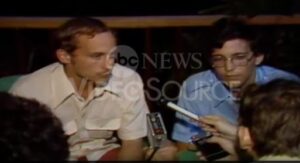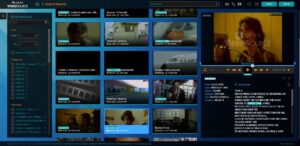Archival footage of Jonestown survivors sitting shellshocked and perturbed inside a bare-bones colonial-era hotel in the capital of Guyana, as reporters – neverending swarms of reporters – demand that they to explain their roles in one of the “top stories of the 20th century,” is an aspect of Peoples Temple history that holds pivotal value but is often undervalued in the broader narrative, and lacks any proper preservation.
Anyone with an interest in researching Peoples Temple and Jonestown has at some point likely come across clips of interviews featuring the survivors, newly-labeled as “cultists,” who struggle to fathom the tragedy they had just experienced. Any discussion of Jonestown is inevitably bound to hazily draw upon one of the countless survivor interviews conducted in the weeks following November 18th. Despite widespread knowledge of the interviews – but likely because of the confusion and bewilderment of the subjects – the survivors’ accounts end up highly misinterpreted, as there’s no systematic documentation or sufficient guide to the dozens of interviews that have surfaced in the intervening years.
Most of the interview footage currently available on platforms such as YouTube consist of compilation clips of sometimes apathetic, seemingly world-weary reporters determined to get the scoop for the next day’s headline, relentlessly dragging answers from survivors. The survivors themselves, many of whom have yet to be spared even a minute to cope with their newfound grief and confusion, appear on camera with a dazed thousand-yard stare, and reluctantly respond to the reporters’ assault.
 In some clips, such as one of a press conference held by a young Stephan Jones, the sole surviving biological son of Jim Jones, who manages to answer the reporters’ questions in calm, measured tones. Other interviews feature Mike and Tim Carter, two surviving brothers who, with Mike Prokes, escaped the mass deaths after being assigned the task of delivering cash-filled suitcases to the Soviet Embassy, now trapped in the Park Hotel in Georgetown as countless reporters swarm them. The younger brother, Mike, fidgets and speaks awkwardly, even as his older brother Tim repeatedly begs for a moment of peace. Still other interview clips feature an eclectic mix of actors in the Jonestown drama, from members of the Concerned Relatives delegation, to defectors who’d survived the shootings at the Port Kaituma airstrip a few days before, to Jonestown residents who managed to escape the jungle commune in its final moments. These interviews clearly provide an integral component in the earliest attempts to understand “Jonestown.” They provide insights unique as they are haunting into the perspectives of survivors, and foreshadow the reception and cynical treatment that would continue trail them all for years to follow.
In some clips, such as one of a press conference held by a young Stephan Jones, the sole surviving biological son of Jim Jones, who manages to answer the reporters’ questions in calm, measured tones. Other interviews feature Mike and Tim Carter, two surviving brothers who, with Mike Prokes, escaped the mass deaths after being assigned the task of delivering cash-filled suitcases to the Soviet Embassy, now trapped in the Park Hotel in Georgetown as countless reporters swarm them. The younger brother, Mike, fidgets and speaks awkwardly, even as his older brother Tim repeatedly begs for a moment of peace. Still other interview clips feature an eclectic mix of actors in the Jonestown drama, from members of the Concerned Relatives delegation, to defectors who’d survived the shootings at the Port Kaituma airstrip a few days before, to Jonestown residents who managed to escape the jungle commune in its final moments. These interviews clearly provide an integral component in the earliest attempts to understand “Jonestown.” They provide insights unique as they are haunting into the perspectives of survivors, and foreshadow the reception and cynical treatment that would continue trail them all for years to follow.
In addition to providing visceral perspectives of survivors, these interviews provide vital information which perhaps can be appreciated only with the passage of time, including their ability to dispel the numerous rumors and conspiracy theories that continue to plague accounts of the tragedy. Yet despite their clear and intangible value, these interviews are oftentimes taken for granted. Unlike photographs and documents, film and broadcast footage – specifically footage that lies in the vaults of large media corporations – is much more difficult to access and preserve.
Over the years, television networks such as NBC, CBS, and ABC have made their collections of historical and b-roll footage available through online archives or have sourced them out to third-party licensing sites. This has allowed for documentarians to present some of these interviews for their own programs. However, it should be considered that these networks release the footage, not out of a sense of obligation to preserve the history of the event, but solely for financial gain.
The process of licensing and the rise of digital archives have made dozens of digitized clips available for free viewing on the web. Yet untold numbers of hours remain beyond researchers’ and filmmakers’ access.

It should be noted that media companies have taken varying approaches this issue. In comparison with other media companies and third-party licensing sites (e.g., Getty Images, AP News, and Veritone) for example, ABC News has taken a slightly more researcher-friendly approach to their licensing archive, ABC VideoSource,[1] which allows for free preview viewing of their digitized footage – albeit with watermarks.
In addition, the availability of most of this footage is ultimately limited – even within the safeguards of these archives – and clips tend to go offline and disappear arbitrarily. Most of the footage has at some point been reposted on sites like YouTube, but they are exceptionally prone to copyright strikes or random deletions, whether by the account owner or by YouTube itself. Even the list of video links compiled by this website constantly faces the challenge of dead or deleted videos, many of which have not yet been reposted elsewhere.
But then, what is the best solution to preserving the Jonestown survivor interviews and other aftermath footage before they become permanently obsolete?
There is no simple or straightforward solution. As this site’s research director Fielding McGehee pointed out in a 2017 report, YouTube is “a format which does not lend itself to historical preservation …[and] many [videos] are designed to be short-lived…”[2] Even if footage is repeatedly reuploaded and mirrored to YouTube and other video-streaming sites, there is no guarantee that this footage will remain available perpetually.
As long as the copyright to any Jonestown footage and survivor interview lies within the purview of large media corporations, any attempt at preservation is likely futile for now.
Ultimately, in spite of the arduous challenge presented by network policies and the fragility of website postings, this should not discourage any attempt to preserve, or at least recognize the inherent value of the survivor interviews. Even if the actual footage of these interviews cannot be permanently preserved with general accessibility in consideration, their contents still can be preserved through other mediums, arguably best in the format of transcripts. They cannot capture the emotional essence of video interviews with survivors, but they can at least preserve the substance of the interviews, and serve as a resource for future generations of Temple researchers to reference. Similar to the hundreds of Peoples Temple audiotape transcripts available on this site, there’s no reason that the survivor interviews shouldn’t be preserved as well. Although it is clearly an ambitious initiative – and impossible to identify, transcribe, and catalog every single one of the survivor interviews with precision – any attempt to capture as many of them as possible nevertheless makes a critical impact in the broader scheme of the preservation of Peoples Temple history.
I have transcribed a handful of survivor interviews myself, and others are in the process of being transcribed, to best ensure that this facet of Jonestown history is available for future reference. A new page under the Aftermath section of the Primary Sources category on the Jonestown Institute site is entirely dedicated to the multitude of survivor interviews that exist, and hosts both transcripts and links to videos of interviews.[3] The limited contents and scope of the page will eventually expand and encompass a greater variety of interview documentation, and serve as a directory for the numerous interview clips that deserve to be properly recognized and preserved.
Ultimately, no matter what lies in the fate of the Jonestown survivor interviews, their value is still clearly evident within the greater narrative of Peoples Temple. The interviews can only serve to contextualize, and perhaps even further humanize, the perspectives of survivors that have been either lost or – compounding the tragedy – twisted and misrepresented throughout the decades.
Notes
[1] A variety of Jonestown aftermath footage and interviews may be viewed by searching “Jonestown” at https://www.abcnewsvsource.com/search
[2] Fielding M. McGehee, “Jonestown Videos Sought for Cataloguing and Preservation,” Alternative Considerations of Jonestown and Peoples Temple, October 29, 2017, https://jonestown.sdsu.edu/?page_id=71066.
[3] See Interviews with Survivors in Georgetown
(Aliah Mohmand is a student with an interest in Peoples Temple. Her interest began in 2021, and her research encouraged her to transcribe survivor interviews and to write for the Institute. She may be reached at aliahmohmand@gmail.com.)